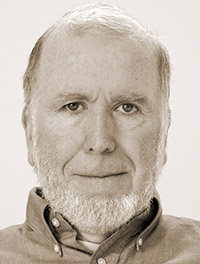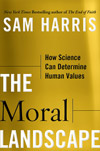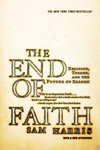In this week’s eSkeptic:

Skepticality

Faith, Science —
and Bad Religion
Over the years Skepticality has featured many science educators, and more than a few musicians. This week, Swoopy talks with Dr. Greg Graffin, a professor of life sciences at the University of California at Los Angles who also happens to be the lead singer and songwriter for the legendary punk band Bad Religion.
As well as touring in support of The Dissent of Man, Bad Religion’s 14th studio album, Dr. Graffin has just released his memoir Anarchy Evolution: Faith, Science and Bad Religion in a World Without God (co-authored with Steve Olson).
MonsterTalk

On Monsters
This week on MonsterTalk, author Stephen Asma (Professor of Philosophy at Columbia College Chicago) speaks about his comprehensive book surveying Western monster-lore.
Is humankind’s fascination with monsters broader than any single cause? Asma’s On Monsters examines hundreds of legends — and their cultural, psychological and social implications.
Lecture at Caltech this Sunday

What Technology Wants
with Kevin Kelly
Sunday, November 7, 2010 at 2 pm
NOTE: Daylight Saving Time ends in the United States on Sunday, November 7, 2010 at 2 am.
Baxter Lecture Hall
KEVIN KELLY, THE EDITOR AND PUBLISHER of Whole Earth Review and one of the founders and editors of Wired magazine, explains why most of us have a love/hate relationship with new inventions, and why this conflict as inherent to all technology. But he also argues that technology is an extension of life — and an acceleration of the mind. Technology is not anti-nature, but rather the “seventh kingdom” of life: it now shares with life certain biases, urges, needs and tendencies. The system of technology that Kelly calls the “technium,” unconsciously “wants” to head in certain directions, just as do life and evolution. The technium functions as a living, natural system. Just as evolution has tendencies, urges, trajectories, established forms, and a direction, so too does the technium. Where is it headed? What is the true nature of its increasing presence in our society? And how do the goals of the technological agenda relate to humanity’s goals? Come to this lecture to find out from one of the true visionaries of our time!
Tickets are first come first served at the door. Seating is limited. $8 for Skeptics Society members and the JPL/Caltech community, $10 for nonmembers. Your admission fee is a donation that pays for our lecture expenses. Please note that Daylight Saving Time ends in the United States on Sunday, November 7, 2010 at 2 am.
About this week’s eSkeptic
In this week’s eSkeptic, we present an article from Skeptic magazine vol. 2, no. 2 (1993) wherein physicist Milton Rothman examines the relationship between science and religion and the extent to which a scientist should apply his belief in realism to all aspects of our knowledge of the universe.
Milton Rothman received his Ph.D. in physics after World War II. He spent several years in nuclear physics research at the Bartol Research Foundation in Swarthmore, PA, ten years in plasma physics research at the Princeton Plasma Physics Laboratory, and ten years as Professor of physics at Trenton State College. He has written some science fiction, a large number of technical papers and popular articles, and eight books. His latest book is The Science Gap: Dispelling the Myths and Understanding the Reality of Science (Prometheus Books, 1992).

Realism and Religion
A Physicist Examines the Basis for Belief
by Milton Rothman
What should a scientist think about religion and God? Is there a relationship between belief in religion and the paranormal? Just how far should a skeptic go in challenging the belief systems of the world? Finally, what is the basis for our belief in anything? These are the fundamental questions I will address in this essay that touches on one of the most sensitive issues in skepticism — the relationship between science and religion and the extent to which the scientist should apply his belief in realism to all aspects of our knowledge of the universe.
1. Dealing Realistically with the Paranormal
There are two ways of testing claims of the paranormal. By far the most popular is top-down observation: See what the psychic predicts — is this what actually happens? Look at the astrologer’s horoscope — does it say anything valid about events in the real world? Analyze the results of ESP experiments and show what, if anything, is wrong with them. See if you can find physical evidence of UFOs or else explain how the claimed evidence was faked … and so on. Theory plays a minor role.
The other way is bottom-up theoretical: examine the purported paranormal phenomenon in light of general principles firmly established within modern physics. Is the claim plausible according to the standard model of particle physics, the principle of relativity, the theory of gravitation, and the rest of verified knowledge? For example, does a proposed machine require the expenditure of energy without an energy source? Then it cannot happen. Does ESP require that information travels faster than the speed of light? Then it cannot happen. Does a UFO defy gravity and hang suspended high in the air with no visible means of support? Then it cannot happen.
These are not arbitrary or a priori judgements. The experiments that establish the general laws have already been done. You do not have to repeat the experiments for special cases of ESP and UFOs. General laws that apply to everything in the world also must apply to the particular cases of ESP and UFOs. (Those who object to this statement may refute it by proving the existence of objects or events in the universe that do not follow regular and general laws of nature.)
The prerequisite for thinking in terms of physical laws is a framework of philosophical realism. All actual events in nature are described by realistic theories. (For a definition of realism see Section 2.) By contrast, theories concerning paranormal phenomena almost invariably are associated with the world view of philosophical idealism. Idealists believe that ideas are more important than physical evidence. If an idealist believes that something exists, then that is the same as knowing it exists. The thought is father to the fact, rather than the other way around. An extreme Platonist might believe that a chair is merely a hypothetical entity, but his belief in supernatural forces represents truth.
I do not wish to diminish the importance of ideas. To a realist, however, if an idea is to be of use, it must be an idea about something that actually exists. Since “beauty” is a mental construct that refers to something we all experience, the idea of beauty is a valid one. The idea of psychic energy, however, refers to something that has never been observed and, moreover, produces no observable effects. (This is not to be confused with a belief in psychic energy, which may produce observable effects.)
We find, then, that when events are governed by idealistic (as opposed to realistic) theories, they invariably turn out to be mental constructs involving unreal entities and forces such as psychic energy, spiritual energy, an incorporeal “mind,” “vibrations,” antigravity, the ether, supernatural beings, and the like. Whoever claims the reality of imaginary and nonexistent things is operating in an idealistic framework. His idea or belief takes precedence over the existence (or non-existence) of physical evidence.
In view of these observations it appears to me that those innately skeptical toward claims of the paranormal operate from a realistic philosophy, while those who tend to believe in the paranormal use a reference frame that is idealistic in nature. This dichotomy generally characterizes the distinction between normal and paranormal, skeptic and believer.
It is not my aim to rehash the history of science and elaborate on the many conflicts that have arisen between realists and idealists. My position is that now, at the end of the twentieth century, the conflicts have been resolved in favor of realism, especially in the realm of things that happen at the macroscopic, human level. The idealists continue to mount a rear guard action in the microscopic domain, particularly in the area of quantum physics, but it is a vain effort. Many have written on this topic elsewhere, notably Bunge, 1967, 1993; Herbert, 1985; Popper, 1967; and Bell, 1987. Some of the arguments I make below have already appeared in prior work (Rothman, 1988, 1992).
2. Realism and Idealism
Realism is the idea that the things that exist in the world have an objective existence; they are there whether or not humans observe them. Furthermore, these objects are made of particles subject to physical laws that govern their properties and behaviors. These laws result from the structure of the universe; they do not depend on human desires or intentions. Neither do they depend on the will of supernatural beings.
As an illustration of how nature does not care about what humans think, consider that there are at least eleven ways of writing equations describing the motion of a baseball or a planet. (Hamilton’s equations, Lagrange’s equations, Maupertuis’ law of least action, etc.) These equations are all equivalent to Newton’s second law of motion, but each is different in structure from the others. However, there is only one reality that these several equations describe.
Idealism, on the other hand, supposes that the human mind has some say about the way the world is. The foundation of idealism is the notion that “mind” is something that exists independently of the body. While mind-body dualism has been abandoned by all neuroscientists, it is still part of the idealist philosophy. The extreme idealist thinks that the outside world exists because the inside world of his mind creates the outside world. Theories of idealism less extreme admit to the existence of the universe, but hold that our ideas about reality are no more than opinions created in the mind, or that the nature of the things in the world is somehow influenced by what we think about them. This is the Platonic view. (The very fact that there are so many theories of idealism contesting for acceptance implies that idealism itself is an unverifiable opinion.)
A saying, popular in some circles, is: “Nothing exists until it is observed.” If you believe this notion then it makes sense to ask the hoary question, “If a tree falls in the forest, and there is nobody there to hear it, does it make a sound?” To a physicist this is a non-problem. The question is answered simply by defining what we mean by a sound: It is a vibration in the air or other medium. A person with idealistic tendencies will say that the sound does not exist unless somebody hears it.
Most working scientists who take the time to think about it adopt the viewpoint that realism is the only rational basis for a science. Yet some scientists make statements that are remarkably idealistic in nature. This is particularly true in the context of quantum mechanics, and a number of popular books have appeared during the past two decades whose sole effect has been to mislead and confuse the public. These books have to do with the nature of elementary particles as described by quantum mechanics. In quantum theory the location of an electron or photon is undefined until it is detected, and some properties of the particle (such as spin or direction of polarization) are in part determined by the state of the detector set up to observe the particle. This baffling phenomenon has given rise to the common — and misguided — belief that the particle does not exist until it is observed.
Saying that a particle does not exist until it is observed is quite different from the legitimate statement that the observed properties of the object depend to some extent on the nature of the observation. It is something like my state of mind in listening to music. If I turn on the radio early in the morning and the station happens to be broadcasting a commercial containing loud rock-and-roll, I will complain bitterly about how raucous this is, and rush to shut it off. But, at night, if I have had a drink and am in the mood for dancing, then the same music is quite acceptable. “Beauty” and “ugly” depend on the state of the observer. But the music itself, as defined by the vibrations in the air, has not changed.
Exemplifying the idealist scientist, the physicist Werner Heisenberg has been quoted as saying “The idea of an objective real world whose smallest parts exist objectively in the same sense as stones or trees exist, independently of whether or not we observe them … is impossible.” John Gribben writes “Nothing is real unless we look at it, and it ceases to be real as soon as we stop looking.” (Gribben, 1984, p. 173) In spite of comments such as these, the realistic point of view is supported by a number of observations:
A. While certain properties of a particle (such as spin and polarization) are contingent on the way the observation is made, their fundamental properties, such as rest mass and electric charge, are intrinsic and do not depend on how they are measured or who does the measurement. A glance at a table of fundamental constants, such as is found in the Handbook of Chemistry and Physics, lists the electron charge, the electron mass, the proton mass, and many other physical quantities to a very large number of significant digits. These quantities are not invented or made up: they are the results of numerous measurements and are objective, intrinsic properties of real physical objects. (Indeed, a particle is defined by the totality of its fundamental properties: an electron is a particle with a certain mass, electric charge, and spin. A particle with a different mass, charge, and spin is a different particle.)
B. The speed of light has been measured by many people all around the world. Everybody gets the same number within the limits of error — and the limits of error in recent years have become exceedingly small. There is no way this could happen if the speed of light was determined by the person measuring it. The same is true for all the other fundamental constants. The fact that everybody gets the same number when measuring these quantities is proof that the measurements represent the properties of real objects with objective existence.
C. Saying that an object does not exist until it is observed leads to a logical fallacy — a reductio ad absurdum. First let us define “observed.” In physics, a particle is observed when it is detected — that is, when it deposits its energy in an appropriate instrument or nerve cell. Idealists, on the other hand, tell us that observation only takes place when the observer is conscious of the observation. Now, suppose that I am looking at a distant star. In common parlance it can be said that I am observing the star. To the idealist it follows that the star does not exist until it comes into my consciousness. But this conclusion is the result of semantic slippage. It must be understood that I am not directly observing the star with my eye. Rather, I am detecting photons which were emitted by the star a long time ago and which, after traveling many light-years, enter my eye. The physical detection takes place in the retina of the eye, where the photons vanish, giving up their energy to a number of electrons in retinal cells by means of the photoelectric effect. These electrons initiate an electrochemical impulse that travels through the optic nerve into my brain. Finally, then, I become aware of the impact of the original photons. I do not become conscious of the photon detection until after the signals have been processed by the visual center of the brain. This does not occur until several milliseconds after the initial detection of the photons. Do the photons not exist until I am conscious of their detection? If you hold to the idealist stance and insist on that interpretation, then you are saying that a non-existent object produced a signal in my retina, and only with subsequent consciousness did it become existent. Or to put it another way, the photons were detected in the retina before they existed. This is a reductio ad absurdum.
D. The realistic view is that a particle detector can be totally inanimate; consciousness is not required for particle detection. Consider the detection of particles by a scintillation counter that sends signals into a computer. The computer adds up all the counts and stores them in the memory. A human may or may not look at the stored numbers. He may look at them days or years after the initial detection. Do we say that the particles do not exist until they stimulate the consciousness of a human being? Physically, this is an absurd statement, for it implies that the counters were triggered by a nonexistent particle. In reality the particles exist whether or not they are detected. The detection process merely tells us where they have come to rest and the computer counts how many particles were detected. The computer, in turn, may trigger other mechanisms; e.g., an alarm may ring if the particles are detected faster than a preset rate. The final effect does not depend on the presence of humans. (Absurdities proliferate without end once you start thinking that particles do not exist until they are detected. Think of a particle accelerator shooting high energy electrons at a target to produce nuclear reactions. Is it accelerating non-existent electrons producing reactions that do not exist until their products hit the detector?)
E. The major controversies concerning realism center on “quantum strangeness” — a phenomenon associated with the famous Einstein-Podolsky-Rosen paper of 1935 (Einstein, 1935). These phenomena all have to do with particles (electrons, photons) traveling in opposite directions, but effectively connected or correlated in some manner. For example, if an atom emits two photons by an orbital electron dropping two levels in cascade, these two photons will go off in opposite directions and will have identical polarizations. They are now detected in coincidence by distant detectors (A and B) polarized in the same direction. If the polarization of one detector is suddenly changed while the photons are in mid-flight, this will change the number of photons counted simultaneously in both detectors. It is as though detector A instantly knows what is happening at far away detector B. This “spooky” action at a distance is what arouses all the mystical theories of the idealists, who assume immediately that this kind of connectedness between the two photons should make it possible to send messages at speeds faster than light and perhaps provides a mechanism for ESP. However, a close examination of the experiments shows that in reality nothing about them allows information to be sent from one location to another faster than the speed of light. (Rothman, 1988, p. 83, 1992, p. 85; Bell, 1987, p. 60; Chiao, Kwiat, & Steinberg, 1993.) Thus, as far as events at the human level are concerned, the rules of realism still apply.
3. The Nature of Realism
Realism and idealism are philosophies — points of view. As such, they can be neither proved nor disproved. They may be looked on as fundamental postulates. However, individual realistic or idealistic theories may or may not be falsifiable and verifiable.
All realistic theories are falsifiable (by definition) and thus are legitimate empirical theories, testable by experiment. A theory that cannot be, in principle, falsified cannot be a realistic theory. The majority of idealistic theories are not falsifiable, and so are not empirical theories. In particular, theories based on religion (such as creationism) are unfalsifiable. As an example, suppose you object to creationism on the grounds that the fossil record (dated by radioactivity) shows that animals lived on earth millions of years ago. The creationist replies by saying God changed the decay rates of the radioactive isotopes about 8,000 years ago so that it merely appears as though the fossil is millions of years old. In actuality, the creationists say, God put the fossils there less than 10,000 years ago, for reasons known only to the creator. Whatever evidence you bring up to falsify the theory, the creationists claim God planted it there for His own mysterious purposes. These shifting and changeable ad-hoc assumptions make it possible to prove anything you want and so make creationism an unfalsifiable theory. The same method is used by ESP experimenters when they claim that the presence of skeptics in the same room as the experiment causes the results to be negative. The theory is rigged so that it is unfalsifiable.
Perhaps the major reason for rejecting idealistic theories is that they invariably involve entities such as an incorporeal “mind” (separate from body), which cannot be detected by any physical means, and whose properties are subjective (that is, invented) so that there is no way of measuring them in any objective manner. Unmeasurable and undetectable entities such as phlogiston, caloric, and the ether have long vanished from the scientific vocabulary.
Realistic theories, on the other hand, always involve things whose properties can be measured by objective, physical instruments. Realists start with one major assumption: there is but one reality, and the job of scientists is to determine its nature. Devotees of the Rashomon effect (according to which several people see the same event but each tells a different story) like to explain it by saying: “Each person sees his or her own reality.” However, this is but a metaphor. In actuality each person sees his own interpretation of reality, colored by his own preconceptions. This is quite a different matter. There is only one reality; only one event took place.
Over the past century scientists have learned a great deal about the nature of reality. Physicists, in certain areas, are closing in on a complete picture, at least on a fundamental level. Neuroscientists, investigating the nature of consciousness, are far from the end, but feel they are on the right track when they confine their investigations to physical events taking place within the nervous system, visualizing the human being as a kind of computer, and avoiding imponderables such as “psychic energy” and mind-body dualism.
In this discussion I will concentrate on physics, for this where we find the tools to test most paranormal theories for their pseudoscientific content. The part of physics that underlies all other knowledge is particle physics: the study of elementary particles and how they interact. If we know all the types of particles that exist, and if we know all the ways in which they interact, then we can predict what activities are possible and what are not possible. Particle physics does not allow us to predict all the complexities of life in the biological sphere, but it does allow us to stipulate what actions cannot possibly take place, and so it gives us a simple tool for identifying claims of the paranormal.
The importance of this cannot be overestimated. One of the myths of popular culture is the claim that “Nothing is impossible.” Nothing can be farther from the truth. Modern physics clearly enables us to know what actions are possible and what are impossible. Particle physics as we know it now is based on the standard model of particle physics, first elaborated in the 1960s and 70s. Although this model is not complete, it has no known discrepancy with any experiment to date. Thus, any future, more complete theories of particle physics must include the standard model. Many accounts of the standard model are in print (Davies, 1984, pp. 70 & 80; Salam, 1989, p. 481; Rothman, 1992, p. 51; Weinberg, 1992, p. 58). For our purposes only a few essentials need be noted here:
A. All matter consists of twelve kinds of particles, organized into three groups, or families. In fact, all matter existing under ordinary conditions — the matter that you and I come into contact with — consists of only the four particles in one family: the up quark, the down quark, the electron, and the electron-neutrino. (The familiar proton and neutron are made up of combinations of quarks.) All the actions that take place in the universe result from the four different forces that control the interactions between the twelve kinds of particles. These forces are the gravitational, electromagnetic, strong nuclear, and weak nuclear forces.
B. Each of the four forces is characterized by certain symmetries in space and time. Through Noether’s theorem, each symmetry is connected with a conservation law which states that a particular quantity in a system remains constant, even though everything else may be changing. For example, the force between two particles does not depend on time. (This is a symmetry, because you can set your clocks any time you like without changing the equations of motion.) Noether’s theorem tells us the result of this condition: it tells us that there can be no change in the energy of the system in which these particles are interacting. Energy is the conserved quantity in this case.
The consequences of the last statement are very pervasive. It means that no matter what happens, no matter how complex the system, the law of conservation of energy holds true: energy cannot be created or lost. Laws such as this are not “just theories.” They have been experimentally confirmed to an extraordinary degree of precision with experiments on elementary particles (Rothman, 1972, 1989, p. 101). If this law applies to the elementary particles, it applies to all things made of these particles. (Some authors refer to the First Law of Thermodynamics, which is simply a special case of conservation of energy as applied to heat engines.)
Conservation of energy, together with our knowledge of the four forces, enables us to be skeptical about claims of ESP. This is because any information entering a person’s brain must carry enough energy with it to activate signals in the nervous system. This information must be transmitted from one brain to another via one of the four forces. But none of the four forces will do. The nuclear forces are short-range; they cannot possibly do the job. The gravitational force is too weak. The electromagnetic force can be shielded by metal cages. ESP experimenters claim this does not matter. The electromagnetic force also loses strength with distance according to the inverse-square law. Devotees of ESP claim that distance does not matter. Therefore they must explain telepathy and teleportation by allusion to forces as yet unknown.
This brings us to a crucial point often proffered by paranormalists in defense of their belief: how do we know that there are only twelve fundamental particles? How do we know that there are only four forces? How can we say that there are no other particles and forces waiting to be discovered? This is a question that could not be answered with certainty until 1989, when a new type of experiment made possible by a new generation of high-energy particle accelerators proved with a high degree of confidence that the three families of particles mentioned above are the only families of particles (Rothman, 1992, p. 59; Kinoshita, 1989, p. 22).
Positive proof of this nature contradicts the folksaying common in many circles to the effect that “it is impossible to prove a negative.” This may be true in courts of law, but it is not true in physics. Experiments using very high energy accelerators give results that positively tell us there are no more than the three families of particle physics mentioned above. Thus, knowing the properties of these known particles, we can make definite predictions about what is possible and what is impossible. For example, if you tell the UFO believer that no real UFOs exist on this planet, he will say that you just have not looked in the right place at the right time. The realist, however, has positive proof. The realist says that if the UFO is described as traveling to earth at a speed faster than light and hovers in the air unsupported by mechanical means, then it simply cannot exist. It is not really necessary to look for evidence for or against this UFO, for faster-than-light travel does not exist, and antigravity does not exist. (All particles attract each other by the gravitational force; there is no way to arrange them so that they do anything else.)
We are allowed to make statements like this because it has been established that all normal matter is made of quarks, electrons, and electron-neutrinos. Therefore anything that happens in the world must be allowed by the standard model of particle physics and by the properties of the four forces that control all the things that take place in the world. Conversely, anything not allowed by the standard model cannot happen.
4. Realists and Idealists
It is my contention that realists have a tendency toward skepticism, whereas idealists have a tendency toward belief in unreal things. Realists believe that the only way they can get information about nature is through their senses. They also know that their senses can delude them, and that evidence obtained by instrumental observation is generally more reliable than the raw data pouring through the senses of an individual. The reliability of the evidence is enhanced by repeated observations and also by the ability of scientists to connect the observations into a logical structure through mathematical theory. The structure formed by the interrelatedness of verified theories is extremely rigid and hard to break. Once a scientific structure has been firmly validated, the realist doubts claims of phenomena that contradict that structure. He is a skeptic.
Idealists, on the other hand, believe in the primacy of their own ideas. When told that the laws of physics forbid ESP and faster-than-light travel, the invariable answer is: you do not know what advanced civilizations will discover a thousand years from now, as though the nature of the universe is going to change in that time. The idea — the wish — is stronger than the facts.
Paranormal theories are of two types: mystical and physical. Mystical theories or phenomena are based on entities of a transcendental nature: psychic energy, spiritual energy, auras, direct perception, etc., and include all the varied aspects of ESP, astrology, and new-age beliefs. None of these phenomena exist within the framework of physics. There are only four kinds of energy known to particle physics (in addition to kinetic energy) and none of them are spiritual in nature.
Other paranormal phenomena pretend to be physical in nature: anti-gravity, perpetual motion, faster-than-light travel and time travel are listed under pseudoscience. The anti-gravity enthusiast takes the position that we do not know what gravity is, and therefore we cannot predict what we may yet discover about it. The realist, on the other hand, says we do know how gravity behaves, and what we know tells us that there is no way of arranging matter in such a way as to produce a gravitational repulsion or shield.
While perpetual motion and UFO enthusiasts may not call on mysticism and supernatural entities for their theories, they behave like idealists in the sense that they believe their own ideas are more important than the physical evidence to the contrary. I have carried on a frustrating correspondence with a person who complains that scientists never worry about the cause of gravity. He claims that his theory — based on compressions from outer space — can explain the cause of gravity better than any other theory. This person refuses to acknowledge that his theory cannot even explain the inverse-square law. In addition, he refuses to acknowledge the fact that Einstein did worry about the cause of gravitation and produced the general theory of relativity as a result. He claims his theory is the only valid theory of gravity and it is the duty of scientists to prove him wrong (as though the methods of science are the same as courtroom procedures). Ideas — which he spins out ad infinitum — are more important to this paradoxer than reality.
5. Ordinary and Extraordinary Claims
A saying currently popular among skeptics is that “extraordinary claims require extraordinary proof.” An example of an extraordinary claim is one that violates the fundamental laws of physics — that requires actions not allowed within the standard model of particle physics. To prove an extraordinary claim of a physical sort — let us say a gravitational shield providing the power of levitation — one would have to do an experiment that verifies the claim. The method of doing this experiment would be ordinary enough, but if the result verified the claim it would be a most extraordinary result.
In the medical or psychological sciences one often must resort to statistical experiments using the methods of epidemiology. ESP experiments are of this nature. Medical epidemiological studies are notorious in producing conflicting results. Some reports say that food A is bad for you; others say that food A is good for you. Some reports say that low frequency electromagnetic fields cause cancer; other reports say they do not. The reason is that the studies are looking for tiny effects immersed in statistical noise. The same is true for ESP experiments. If the ESP effects were large enough to be both reproducible and useful, they could be verified by ordinary epidemiological methods. They would not require extraordinary methods. Indeed, if ESP effects were sufficiently large, a single experiment would demonstrate their reality.
The moral: extraordinary claims that are valid can be verified by ordinary methods. The reason most extraordinary claims sound so extraordinary is that if they were true they would overthrow everything we know about modern physics. This is why we do not believe them until we have evidence that is irrefutable.
6. Reality and Religion
The entities science deals with are observable with appropriate instruments. Or else, as in the case of quarks, they are not directly observable, but they produce measurable effects (and we know why they are hiding). These entities interact with each other according to laws which operate consistently on all forms of matter. The purpose of science is to determine what these laws are and how they operate. In the realm of physics this purpose has culminated in the Standard Model of particle physics.
Religion also deals with entities and laws. The entities of religious literature are gods of various kinds, heaven, hell, prayer, supernatural forces, and sacred objects. In modern physics there is no mention of gods, heaven, or hell or, indeed, anything that is in the least bit supernatural. Thus, the realistic weltanschauung has no point of intersection with the religious viewpoint. More than that: there is no objective evidence that demonstrates the reality of gods, heaven, hell, or supernatural forces. On the contrary, there is copious evidence leading to the conclusion that these entities are invented by humans for a variety of psychological reasons. They are simple ways to understand the nature of the universe.
Looked at from this point of view, religion is simply another example of belief in the paranormal. Religious theories require the believer to accept telepathic communication from man to god (prayer), and from god to man (the word of god). There is no requirement to identify what kind of force or interaction carries this telepathic information.
Regardless of advances in scientific knowledge, most people maintain religious beliefs. Thus we must recognize that religion is a real phenomenon from the psychological and sociological point of view. This is easily understood by noting that religious beliefs originated long before we had instruments capable of showing us what the world is really like. Since religious belief is handed down by early training from parent to child, a predisposition to religious belief is difficult to shake off when the child grows to maturity.
This accounts for the fact that so many scientists are religious, even though they have the tools to understand the universe in a rational manner. (I believe, however, that if a poll were taken it would show that the percentage of atheists among scientists is greater than in the public at large. But this is an unsubstantiated guess.) In graduate school I knew a physics student who was so orthodox he would not use a telephone on Saturday. Later he became a very important physicist, head of the department of a major university. Cases like this represent an extreme compartmentalization of two opposing beliefs in different parts of the mind. (I use the term “mind” metaphorically.)
Religion also has dimensions beyond simple matters of gods, heaven, and hell. Religious beliefs deal with ethics and morality; they govern a culture’s behavior. They also provide comfort for those who need it. Prayer and religious music have important effects that can be understood psychologically. For this reason a realistic philosophy that attempts to replace the idealistic philosophies of the religions must tread with care. It must not leave a vacuum, but must create an ethical system that is not based on supernatural entities, together with a way to comfort the masses without the religious opiate.
Religionists often object to scientific explanations, on the ground that reductionist theories are unable to account for complex phenomena such as life and consciousness. However, we can understand life without trying to build up the structure of living organisms from a knowledge of elementary particle theory. The standard model of particle theory merely gives us a framework in which to operate. The study of life from the top down is a more fruitful way to go, and our exploding knowledge of the DNA molecule demonstrates how powerful our methods are. I hereby place a bet that our biologists will learn how to synthesize living matter during the next century.
In conclusion, the ironic fact is that religion has no ability to explain anything. While scientific discovery has increased exponentially during the past century, religious discovery has remained a flat zero. There have been important historical discoveries, but no improvements in explaining where the gods reside, how they interact with man, where the gods lived before the universe was formed, and how they learned how to create the universe. (I use the plural gods, because each religion has its own variety of god.) Recent attempts to claim that a god caused the Big Bang really do not explain anything. They just push the unanswered questions back into the past.
Bibliography
- Bell, J.S. 1987. Speakable and Unspeakable in Quantum Mechanics. Cambridge University Press.
- Bunge, M. 1967. “The Turn of the Tide,” in Quantum Theory and Reality, New York: Springer-Verlag.
- 1993. Letters to the Editor, The Skeptical Inquirer. Vol. 17, No. 2: 217–218.
- Chiao, R.Y., Kwiat, P.G., and Steinberg, A.M. 1993. “Faster than Light?” in Scientific American. Vol. 269, No. 2: 52–60, August, 1993.
- Davies, P. 1984. Superforce. New York. Simon & Schuster.
- Einstein, A., Rosen, N., and Podolsky, B. 1935. Physical Review, Vol. 47: 777.
- Gribben, J. 1984. In Search of Schroedinger’s Cat. New York: Bantam Books.
- Herbert, N. 1985. Quantum Reality: Beyond the New Physics. Garden City: Anchor Press/Doubleday.
- Kinoshita, J. 1989. “The Lost Generation,” Scientific American. Vol. 261, No. 6: p. 22.
- Popper, K. 1967. “Quantum Mechanics without ‘The Observer,”’ in Quantum Theory and Reality. New York: Springer-Verlag.
- Rothman, M. 1972. Discovering the Natural Laws: The Experimental Basis of Physics. Garden City: Doubleday & Co.
- _____1989. Discovering the Natural Laws: The Experimental Basis of Physics. New York: Dover Publications.
- _____1988. A Physicist’s Guide to Skepticism. Buffalo, Prometheus Books.
- _____1992. The Science Gap: Dispelling the Myths and Understanding the Reality of Science. Buffalo, Prometheus Books.
- Salam, A. 1989. “Overview of Particle Physics,” in The New Physics, Davies, P., Ed., Cambridge: Cambridge University Press.
- Weinberg, S. 1992. Dreams of a Final Theory: The Search for the Fundamental Laws of Nature. New York, Pantheon Books.
Skeptical perspectives on religion and reason from Sam Harris
-
 The Moral Landscape:
The Moral Landscape:
How Science Can Determine Human Values
(hardback $26.95) by Sam Harris
-
 Letter to a Christian Nation
Letter to a Christian Nation
(paperback $12) by Sam Harris
-
 The End of Faith:
The End of Faith:
Religion, Terror, and the Future of Reason
(paperback $13.95) by Sam Harris

NEW ON SKEPTICBLOG.ORG
The Eternally Boring Hereafter
After a string of highly successful and critically acclaimed films by Clint Eastwood (Million Dollar Baby, Gran Torino, Invictus, Flags of Our Fathers, Letters from Iwo Jima, etc.), I fully expected his latest, Hereafter, to be so well written (screenplay by Peter Morgan—Frost/Nixon, The Queen) and so compelling that stories about near-death experiences would skyrocket and that I would be preoccupied for months dealing with media inquiries about “true stories” of the hereafter…










